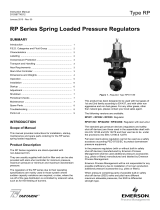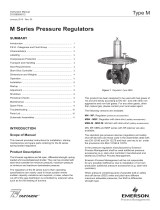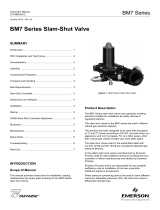Page is loading ...

Type PS/79-1 and PS/79-2
Instruction Manual
D103590X012
January 2015 - Rev. 00
TM
SUMMARY
Introduction ........................................................................ 1
Characteristics .................................................................... 1
Labelling ............................................................................. 2
Dimensions and Weight ...................................................... 2
Installation .......................................................................... 2
Startup ................................................................................ 2
Periodic Checks.................................................................. 2
SEP Statement .................................................................. 2
ATEX Requirements .......................................................... 2
Maintenance ....................................................................... 3
Troubleshooting .................................................................. 4
Parts Lists ........................................................................... 5
Schematic Assemblies........................................................ 6
INTRODUCTION
Scope of Manual
This manual provides installation, startup, maintenance,
troubleshooting, and spare parts for the pilot series PS/79-1
and PS/79-2.
Product Description
Designed for pressure regulators control, the following types
are available:
• PS/79-1 - RE/79-1 - PSO/79-1 - REOPS/79-1
• PS/79-2 - RE/79-2 - PSO/79-2 - REO/79-2
Tightness cover version available on request
(e.g. Types PS/79-1-D and PS/79-2-D).
The full range of PS pilots can be installed in the following
pressure regulators:
FL Series - Cronos Series
This product has been designed to be used with fuel gases of
1st and 2nd family according to EN 437, and with other non
aggressive and non fuel gases. For any other gases, other
than natural gas, please contact your local sales agent.
CHARACTERISTICS
Table 1. Technical Features
APPLICATION
ALLOWABLE
PRESSURE PS
(bar)
SET RANGE W
d
(bar)
BODY AND
COVERS
MATERIAL
Regulator or
Monitor
PS/79-1
25
0.01 - 0.5
Aluminum
PS/79-2 0.5 - 3
1/4-inch NPT female threaded connections.
All PS/ series pilots are supplied with a lter (5μ ltering degree)
and built-in pressure stabilizer, with the exception of Type
PSO/79-1 and PSO/79-2 pilots (supplied without stabilizer).
Type PS/79-1 and PS/79-2 Pilots
Figure 1. Type PS/79-1 or PS/79-2 Pilots

2
Type PS/79-1 and PS/79-2
145
270
LABELLING
APPARECCHIO TIPO /DEVICE TYPE
Wau
DN2
DN1
MATRICOLA
bar
bar
SERIALNr.
°C
FLUIDO GRUPPO
FLUIDGROUP
ANNO
YEAR
HARMONIZED STD.
bar
NORMEARMONIZ.
LEAKAGECLASS
CLASSEDI PERDITA
FUNCTIONALCLASS
CLASSEFUNZIONALE
bar
Wao
Wa
TS
bar
pao
Cg
PS
body
bar PT
=x
PS bar
PS
covers
EN
bar
pmax
BOLOGNAITALY
O.M.T.
1.5Note 4Note 3
Note 2
Note 1
1
-
Figure 2. Label for PS/79-1 and PS/79-2 Pilots
Note 1: See “Characteristics”
Note 2: Year of Manufacture
Note 3: Class 1: -10° to 60°C
Class 2: -20° to 60°C
Note 4: See “Characteristics”
DIMENSIONS AND WEIGHT
INSTALLATION
a. Check that data on the pilot’s plate are compatible with
actual working conditions.
b. Install in accordance with regulator instruction manual.
STARTUP
See the set-up and pilot adjustment instructions applying to
the equipment where the pilot is tted.
PERIODIC CHECKS
Slowly close the outlet slam-shut and check line pressure
between it and regulator. A slight increase in pressure should
be detected: this results from overload due to closing, and
is followed by pressure stabilization. If, however, outlet
pressure continues to rise, then seal is defective. Check if
leak is coming from regulator or pilot, and service.
SEP STATEMENT
Emerson Process declares this product conforms to
Pressure Equipment Directive (PED) 97/23/EC.
Article 3 section 3 and was designed and manufactured in
accordance with sound engineering practice (SEP).
Per Article 3 section 3, this “SEP” product must not bear the
CE marking.
ATEX REQUIREMENTS
!
WARNING
If the provisions of EN 12186 & EN 12279,
nationalregulations,ifany,andspecic
manufacturer recommendations are not
put into practice before installation and
if purge by inert gas is not carried out
before equipment’s start-up and shut-down
operations, a potential external and internal
explosive atmosphere can be present in
equipment & gas pressure regulating/
measuring stations/installations.
If a presence of foreign material in the pipelines is foreseen
and purge by inert gas is not carried out, the following
procedure is recommended to avoid any possible external
ignition source inside the equipment due to mechanical
generated sparks:
Figure 3. Type PS/79-1 and PS/79-2 Pilots Dimensions (mm)
TYPE PS/79-1 AND PS/79-2 FULL RANGE WEIGHT: 2.5 kg

3
Type PS/79-1 and PS/79-2
• drainage to safe area via drain lines of foreign materials, if
any, by inow of fuel gas with low velocity in the pipe-work
(5m/sec)
In any case,
• provisions of Directive 1999/92/EC and 89/655/EC shall
be enforced by gas pressure regulating/measuring station/
installation’s end user
• with a view to preventing and providing protection against
explosions, technical and/or organizational measures
appropriate to the nature of the operation shall be taken
(e.g. : lling/exhausting of fuel gas of internal volume
of the isolated part/entire installation with vent lines
to safe area - 7.5.2 of EN 12186 & 7.4 of EN 12279 ;
monitoring of settings with further exhaust of fuel gas to
safe area ; connection of isolated part/entire installation to
downstream pipeline; ….)
• provision in 9.3 of EN 12186 & 12279 shall be enforced
by pressure regulating/measuring station/installation’s end
user
• external tightness test shall be carried out after each
reassembly at installation site using testing pressure in
accordance with national rules
• periodical check/maintenance for surveillance shall be
carried out complying with national regulations, if any, and
specic manufacturer recommendations.
MAINTENANCE
CAUTION
Servicingshouldbecarriedoutbyqualied,
skilled personnel only.
For further information, please contact our
Technical Support Representatives or our
authorized dealers.
Before servicing, cut off regulator inlet and outlet and release
any trapped pressurized gas. Use suds to check that there
are no leaks.
Replacing Filter
a. Remove screws (key 54), cover (key 58), and replace felt
(key 41). Reassemble by reversing the above sequence.
Replacing Stabilizer Diaphragm and Seal Pad
b. Remove screws (key 54), cover (key 55), spring (key 52)
and diaphragm assembly (key 53, 51, 50, 49, 48, and 47).
Replace diaphragm if necessary.
c. Unscrew seat (key 44) and replace pad holder (key 45).
d. Reassemble by reversing the above sequence.
Replacing Valve Seal Pads
e. Remove plug (key 23) and seat (key 25). Slide out spring
(key 27), pad holder unit (key 29) and forked stem (key 31).
f. Replace pad holder (key 29) and O-ring (key 32).
g. Reassemble by reversing above sequence.
General Maintenance
h. Proceed as directed in the replacement of lter, stabilizer
diaphragm and seal pad, and valve seal pads.
i. Completely release spring (key 5) by turning the adjusting
screw (key 1) counterclockwise.
j. Remove screws (key 10) and cover (key 6).
k. Keep plate (key 8) blocked with a box wrench, unscrew nut
(key 7).
CAUTION
This must be done exactly as described to
prevent damage to or breaking of drilled
needle valve (key 17).
l. Unscrew plate (key 8) from stem (key 12) and slide off split
pin (key 35).
m. In Types RE/79-1 and -2, remove locknut (key 15) by
means of an appropriate wrench and slide out parts
(key 62, 63, 16, and 17), make sure that the surface of
seat (key 61) is intact.
n. Replace any worn seals.
Reassembly
Lubricate the static O-rings with a thin layer of Molykote
55 M, be very careful not to damage the O-rings when
reassembling. No other pilot parts are to be lubricated.
Reassemble parts by reversing the above steps. As you
proceed, make sure that parts move freely and without
friction.
In addition:
o. Once lever (key 36) and stem (key 12) have been
mounted, check that, with stem (key 12) against body
(key 19), clearance between forked stem (key 31) and
register (A) of lever (key 36) is 0.2 to 0.3 mm If not, use
register to correct.

4
Type PS/79-1 and PS/79-2
TROUBLESHOOTING
Table 2. Troubleshooting for Type PS/79-1, PS/79-2, RE/79-1, and RE/79-2 Pilots
SYMPTOMS CAUSE ACTIONS
Desired set point is not reached
Calibration spring (key 5) is too weak Check the springs catalog and replace it with a stronger one
Leaks from pilot connections Check pilot feed connections and proper gas ow feeding
Outlet pressure drops well below set point
Filter (key 41) is clogged preventing proper
through-ow of gas
Clean or replace lter
Pad holder (key 45) is swollen preventing
proper feed ow
Replace pad holder
Pad holder (key 29) is swollen preventing
proper feed ow
Replace pad holder
Outlet pressure increases over set point
Faulty sealing of pad holder (key 45) Replace pad holder
Faulty sealing of pad holder (key 29) Replace pad holder
Slow response to changes in gas demand
Insufcient ow rate of valve seat (key 25) Increase ow by means of register/pin screw (key 24)
Over large calibration jet (key 18)
(only for Types PS/79-1 and PS/79-2)
Replace calibration jet with a smaller one
Overly rapid response to changes in gas
demand, i.e. Hunting
Excessive ow rate of valve seat (key 25) Reduce ow by means of a pin screw (key 24)
Calibration jet (key 18) is too small
(only for Types PS/79-1 and PS/79-2)
Replace calibration jet with a larger one
Incorrect internal parts assembly Check clearance between lever (key 36) and valve seat (key 25)
Gas continually escaping from relief (S)
Defective seal of pad (key 59)
(only for Types PS/79-1 and PS/79-2)
Replace pad
CAUTION
The above clearance can be checked by
gently pulling the stem (key 12) upward. Use
the proper tool to make sure that support
of diaphragm (key 9) on the stem (key 12)
is on the same plane as that supporting the
diaphragm (key 9) in the body (key 19).
p. Mount diaphragm (key 9) and screw on plate (key 8), rst
by hand then with box wrench, always keep diaphragm
(key 9) rmly in place to avoid damage to stem (key 12)
and underlying levers.
q. Holding plate (key 8) rmly in place with box wrench,
tighten nut (key 7).
r. Before remounting cover (key 6), center diaphragm
as follows: mark a reference point (with pencil) on the
diaphragm; turn it to the right without forcing and mark
another reference on body. Now turn diaphragm to the
left and mark a further reference. Position the diaphragm
mark midway between the two marks on the body.
s. Tighten all screws uniformly to ensure proper sealing.
CAUTION
The pilot has a wide range of self-adjustment
values. However, given actual operating
conditions, it may be necessary to assist it
attimesbyndingthebestsettingofpin
screw/register (key 24) or the most suitable

5
Type PS/79-1 and PS/79-2
PARTS LISTS
Type PS/79-1, PS/79-2, RE/79-1 and
RE/79-2 Pilots (See Figure 4)
Item Description
1 Adjusting screw
2 Nut
3 Cap
4 Spring holder
5 Spring
6 Cover
7 Nut
8 Plate
9* Diaphragm
10 Screw
11* Gasket (for Types PS/79-1 and RE/79-1 only)
12 Stem
13 Washer
14 Nut
15 Locking nut
16 Spring
17 Drilled needle valve
18 Jet
19 Body
20* O-ring
21 Plug
22* O-ring
23 Plug
24 Pin screw
25 Seat
26* O-ring
27 Spring
29* Pad holder unit
30 Spacer
31 Forked stem
32* O-ring
33* O-ring
34 Screw
35 Split pin
36 Lever unit
37 Data plate
38 Pin
39 Elastic ring
40* O-ring
41* Felt
42 Filter net
43 Spring
44 Seat
45* Pad holder unit
46* O-ring
47 Screw unit
48* Diaphragm
49 Plate
50 Washer
51 Washer
52 Spring
53 Autolocking nut
54 Screw
55 Cover
56 Plug
57* O-ring
58 Filter cover
Type RE/79-1 and RE/79-2 Pilots Only
Item Description
17 Safety Valve
59* Pad
60* O-ring
61 Seat
62 Thrust bearing
63* “GACO” Ring
Type PS/79-1-D, PS/79-2-D,RE/79-1-D and
RE/79-2-D Pilots (See Figure 4)
Item Description
69* O-ring
70 Elastic ring
71* O-ring
Type REOPS/79-1 Pilot (See Figure 4)
Item Description
77 Body
Rubber parts marked with (*) are supplied in the “spare parts
kit”, recommended as stock.
To order the kit it is necessary to communicate to us the type
of the pilot and its serial number.

6
Type PS/79-1 and PS/79-2
40 54 41
42
58
4854
55
38 3939
40 54 41
42
58
4344454647484954
50
53
55
52
51
A
A
40 54 41
42
58
4854
55
434445464749
50
53
52
51
M
V
1 2
3
4
5
6
7
9 10 11
8
12
13
1415
16
18
18
17
19
20
21
2223
24255657
37
35
36
34
33
32
31
30
29
2827
26
B
R
A
77
39 38 3939 38 39
PARTIAL SECTION C-C
TYPE PS/79-1-2 AND RE/79-1-2
SECTION A-A
TYPE PS/79-1-2
TYPE REOPS/79-1 AND REO/79-2 TYPE PSO/79-1-2
DETAIL
REOPS/79-1
DETAIL
REOPS/79-1
Figure 4. Type PS/79-1, PS/79-2, and RE/79-2 Pilots Assemblies
SCHEMATIC
ASSEMBLIES

7
Type PS/79-1 and PS/79-2
15
63
62
16
17
59
60
61
19
1
71
3
69
6
70
73 74
S
TYPE RE/79-1-2 TYPE
PS/79-1-D
RE/79-1-D
PS/79-2-D
RE/79-2-D
Figure 4. Type PS/79-1, PS/79-2, and RE/79-2 Pilots Assemblies (continued)
CODE CONECTIONS
M Upstream of the regulator
R To the regulator (loading pressure)
S Downstream or safe area
V Downstream of the regulator
Table 3. Type PS/79-1 and PS/79-2 Pilot Connections

Type PS/79-1 and PS/79-2
The Emerson logo is a trademark and service mark of Emerson Electric Co. All other marks are the property of their prospective owners. Tartarini is a mark of O.M.T. Ofcina Meccanica Tartarini s.r.l.,
a business of Emerson Process Management.
The contents of this publication are presented for informational purposes only, and while every effort has been made to ensure their accuracy, they are not to be construed as warranties or guarantees,
express or implied, regarding the products or services described herein or their use or applicability. We reserve the right to modify or improve the designs or specications of such products at any
time without notice.
Emerson Process Management Regulator Technologies, Inc., does not assume responsibility for the selection, use or maintenance of any product. Responsibility for proper selection, use and
maintenance of any Emerson Process Management Regulator Technologies, Inc., product remains solely with the purchaser.
©Emerson Process Management Regulator Technologies, Inc., 2015; All Rights Reserved
Industrial Regulators
Emerson Process Management
Regulator Technologies, Inc.
USA - Headquarters
McKinney, Texas 75070, USA
Tel: +1 800 558 5853
Outside U.S. +1 972 548 3574
Asia-Pacic
Shanghai 201206, China
Tel: +86 21 2892 9000
Europe
Bologna 40013, Italy
Tel: +39 051 419 0611
Middle East and Africa
Dubai, United Arab Emirates
Tel: +971 4811 8100
For further information visit www.emersonprocess.com/regulators
Natural Gas Technologies
Emerson Process Management
Regulator Technologies, Inc.
USA - Headquarters
McKinney, Texas 75070, USA
Tel: +1 800 558 5853
Outside U.S. +1 972 548 3574
Asia-Pacic
Singapore 128461, Singapore
Tel: +65 6777 8337
Europe
O.M.T. Tartarini s.r.l. Via P. Fabbri 1,
I-40013 Castel Maggiore (Bologna), Italy
Tel: +39 051 419 0611
Francel SAS, 3 ave Victor Hugo,
CS 80125 - Chartres 28008, France
Tel: +33 2 37 33 47 00
Middle East and Africa
Dubai, United Arab Emirates
Tel: +971 4811 8100
TESCOM
Emerson Process Management
Tescom Corporation
USA - Headquarters
Elk River, Minnesota 55330-2445, USA
Tels: +1 763 241 3238
+1 800 447 1250
Asia-Pacic
Shangai 201206, China
Tel: +86 21 2892 9499
Europe
Selmsdorf 23923, Germany
Tel: +49 38823 31 287
O.M.T. Ofcina Meccanica Tartarini S.R.L., R.E.A 184221 BO Cod. Fisc. 00623720372 Part. IVA 00519501209 N° IVA CEE IT 00519501209,
Cap. Soc. 1.548 000 Euro i.v. R.I. 00623720372 - M BO 020330
Francel SAS, SIRET 552 068 637 00057 APE 2651B, N° TVA : FR84552068637, RCS Chartres B 552 068 637, SAS capital 534 400 Euro
/









